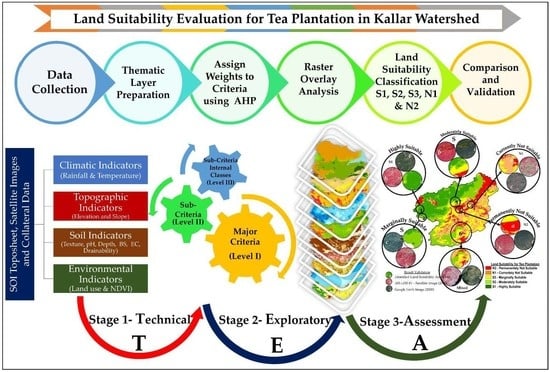Land Suitability Evaluation of Tea (Camellia sinensis L.) Plantation in Kallar Watershed of Nilgiri Bioreserve, India
Abstract
1. Introduction
2. Materials and Methods
2.1. Regional Setting
2.2. Datasets and Methods
2.3. Multi-Criteria Evaluation
2.4. Crop Suitability Criteria and Land Suitability for Tea Plantation
2.5. Validation Method of Generated Results
3. Results
3.1. MCE-Based Spatial AHP in Land Suitability Analysis for Tea
3.2. Evaluation of Land Suitability Criteria for Tea Plantations
3.2.1. Climatic Indicators (Precipitation and Temperature)
3.2.2. Topographic Indicator (Relief and Slope)
3.2.3. Soil Indicators (pH, Depth, BS, EC, Drainability)
3.2.4. Environmental Indicators (Land Use and NDVI)
3.3. Land Suitability for Tea Plantations
4. Discussion
5. Conclusions
Author Contributions
Funding
Data Availability Statement
Acknowledgments
Conflicts of Interest
References
- Banerjee, B. Botanical classification of tea. In Tea: Cultivation to Consumption; Willson, K.C., Clifford, M.N., Eds.; Chapman and Hall: London, UK, 1992; pp. 25–51. [Google Scholar]
- Sealy, J. Species of Camellia in cultivation. J. R. Hortic. Soc. 1937, 62, 352–369. [Google Scholar]
- Baruah, D. The Tea Industry of Assam: Origin and Development; EBH Publishers: Guwahati, India, 2007. [Google Scholar]
- Pandey, K.B.; Rizvi, S.I. Plant polyphenols as dietary antioxidants in human health and disease. Oxidative Med. Cell. Longev. 2009, 2, 270–278. [Google Scholar] [CrossRef] [PubMed]
- Sen, G.; Bera, B. Mini Review-Black Tea as a part of daily diet: A boon for healthy living. Int. J. Tea Sci. 2013, 9, 51–59. [Google Scholar]
- Chung, F.L.; Schwartz, J.; Herzog, C.R.; Yang, Y.M. Tea and cancer prevention: Studies in animals and humans. J. Nutr. 2003, 13, 3268–3274. [Google Scholar] [CrossRef] [PubMed]
- Mackenzie, T.; Leary, L.; Brooks, W.B. The effect of an extract of green and black tea on glucose control in adults with type 2 diabetes mellitus: Double-blind randomised study. Metabolism 2007, 56, 1340–1344. [Google Scholar] [CrossRef]
- Morshedi, A.; Rahmatabadi, D.H.M. Chronic consumption of Kombucha and Black Tea prevents weight loss in diabetic rats. Iran. J. Diabetes Obes. 2010, 2, 23–26. [Google Scholar]
- Deka, A.; Vita, J.A. Tea and cardiovascular disease. Pharmacol. Res. 2011, 54, 136–145. [Google Scholar] [CrossRef]
- Almajano, M.P.; Carbo, R.; Jiménez, J.A.L.; Gordon, M.H. Antioxidant and antimicrobial activities of tea infusions. Food Chem. 2008, 108, 55–63. [Google Scholar] [CrossRef]
- Crouvezier, S.; Powell, B.; Keir, D.; Yaqoob, P. The effects of phenolic components of tea on the production of pro- and anti-inflammatory cytokines by human leukocytes in vitro. Cytokine 2011, 13, 280–286. [Google Scholar] [CrossRef]
- Shukla, Y.; Taneja, P. Anticarcinogenic effect of black tea on pulmonary tumors in Swiss albino mice. Cancer Lett. 2002, 176, 137–141. [Google Scholar] [CrossRef]
- Feizizadeh, B.; Blaschke, T. Land suitability analysis for Tabriz County, Iran: A multi-criteria evaluation approach using GIS. J. Environ. Plan. Manag. 2012, 1, 1–23. [Google Scholar] [CrossRef]
- Kihoro, J.; Bosco, N.J.; Murage, H. Suitability analysis for rice growing sites using a multi-criteria evaluation and GIS approach in great Mwea region, Kenya. SpringerPlus 2013, 2, 265. [Google Scholar] [CrossRef] [PubMed]
- Abdel Rahman, M.A.E.; Hegde, R.; Natarajan, A. Assessment of land suitability and capability by integrating remote sensing and GIS for agriculture in Chamarajanagar district, Karnataka, India. Egypt. J. Remote Sens. Space Sci. 2016, 19, 125–141. [Google Scholar] [CrossRef]
- Al-Shalabi, M.A.; Mansor, S.B.; Ahmed, N.B.; Shiriff, R. GIS Based Multicriteria Approaches to Housing site suitability assessment. In Proceedings of the XXIII FIG Congress, Munich, Germany, 8–13 October 2006. [Google Scholar]
- Bandyopadhyay, S.; Jaiswal, R.; Hegde, V.; Jayaraman, V. Assessment of land suitability potentials for agriculture using a remote sensing and GIS based approach. Int. J. Remote Sens. 2009, 30, 879–895. [Google Scholar] [CrossRef]
- Bhagat, R.; Singh, S.; Sood, C.; Rana, R.; Kalia, V.; Pradhan, S.; Immerzeel, W.; Shrestha, B. Land suitability analysis for cereal production in Himachal Pradesh (India) using Geographical Information System. J. Indian Soc. Remote Sens. 2009, 37, 233. [Google Scholar] [CrossRef]
- Akıncı, H.; Özalp, A.Y.; Turgut, B. Agricultural land use suitability analysis using GIS and AHP technique. Comput. Electron. Agric. 2013, 97, 71–82. [Google Scholar] [CrossRef]
- Chuong, H.V. Multicriteria Land Suitability Evaluation for Crops Using GIS at Community Level in Central Vietnam with case study in Thuy Bang-Thua Thien Hue province. In Proceedings of the International Symposium on Geo-Informatics for Spatial Infrastructure Development in Earth and Allied Sciences, Hanoi, Vietnam, 9–11 December 2008. [Google Scholar]
- Rahaman, S.A.; Aruchamy, S. GIS-based land suitability analysis for potato (Solanumtuberosum L) cultivation in Kallar Watershed, Bhavani Basin, Tamil Nadu. Sustain. Dev. Nat. Resour. 2018, 1, 3–17. [Google Scholar]
- Halder, J.C. Land suitability assessment for crop cultivation by using remote sensing and GIS. J. Geogr. Geol. 2013, 5, 65–74. [Google Scholar] [CrossRef]
- FAO. A Framework for Land Evaluation; Food and Agriculture Organization of the United Nations, Soils Bulletin 32; FAO: Rome, Italy, 1976. [Google Scholar]
- FAO. The State of Food and Agriculture; Food and Agriculture Organization of the United Nations, Agriculture series No. 9; FAO: Rome, Italy, 1978. [Google Scholar]
- FAO. Guidelines: Land Evaluation for Rainfed Agriculture; Food and Agriculture Organization of the United Nations, Soils Bulletin 52; FAO: Rome, Italy, 1983. [Google Scholar]
- FAO. Land Evaluation towards a Revised Framework; Food and Agriculture Organization of the United Nations; FAO: Rome, Italy, 2007. [Google Scholar]
- Bagherzadeh, A.; Daneshvar, M.R. Physical land suitability evaluation for specific cereal crops using GIS at Mashhad Plain, Northeast of Iran. Front. Agric. China 2011, 5, 504–513. [Google Scholar] [CrossRef]
- Zabel, F.; Putzenlechner, B.; Mauser, W. Global Agricultural Land Resources—A High Resolution Suitability Evaluation and Its Perspectives until 2100 under Climate Change Conditions. PLoS ONE 2014, 9, e107522. [Google Scholar] [CrossRef]
- Singha, C.; Swain, K.C. Land suitability evaluation criteria for agricultural crop selection: A review. Agric. Rev. 2016, 37, 125–132. [Google Scholar] [CrossRef]
- Raghunath, M. Application of remote sensing and GIS in urban land suitability modeling at parcel level using multi-criteria decision analysis. Indian Institute of Remote Sensing National Remote Sensing Agency Dept. of Space, Govt. of India: Debra Dun, India, 2006; unpublished work. [Google Scholar]
- Roy, D.; Dwivedi, D.; Vijayan, D. (Eds.) Remote Sensing Applications; National Remote Sensing Centre: Hyderabad, India, 2010.
- Raza, S.M.H.; Mahmood, S.A.; Khan, A.A. Delineation of Potential Sites for Rice Cultivation Through Multi-Criteria Evaluation (MCE) Using Remote Sensing and GIS. Int. J. Plant Prod. 2018, 12, 1–11. [Google Scholar] [CrossRef]
- Mustafa, A.A.; Singh, M.; Sahoo, R.N.; Ahmed, N.; Khanna, M.; Sarangi, A.; Mishra, A.K. Land suitability analysis for different crops: A multi criteria decision making approach using remote sensing and GIS. Researcher 2011, 3, 61–84. [Google Scholar]
- Saaty, T.L. A scaling method for priorities in hierarchical structures. J. Math. Psychol. 1977, 15, 231–281. [Google Scholar] [CrossRef]
- Diamond, J.; Wright, J. Design of an Integrated Spatial Information System for Multi objective Land-Use Planning. Environ. Plan. City Anal. City Sci. 1988, 15, 205–214. [Google Scholar] [CrossRef]
- Carver, S. Integrating Multi-Criteria Evaluation with Geographical Information Systems. Int. J. Geogr. Inf. Syst. 1991, 5, 321–339. [Google Scholar] [CrossRef]
- Eastman, J. Multi-criteria evaluation and GIS. Geogr. Inf. Syst. 1995, 1, 493–502. [Google Scholar]
- Malczewski, J. GIS-based multi-criteria analysis: A survey of the literature. Int. J. Geogr. Inf. Sci. 2006, 20, 703–726. [Google Scholar] [CrossRef]
- Saaty, T.L. An exposition on the AHP in reply to the paper’ remarks on the analytic hierarchy process. Manag. Sci. 1990, 36, 259–268. [Google Scholar] [CrossRef]
- Saaty, T.L.; Vargas, L.G. Models, Methods, Concepts and Applications of the Analytic Hierarchy Process; Kluwer Academic Publishers: Norwell, Australia, 2001. [Google Scholar] [CrossRef]
- Cengiz, T.; Akbulak, C. Application of analytical hierarchy process and geographic information systems in land-use suitability evaluation: A case study of Dümrek village (Çanakkale, Turkey). Int. J. Sustain. Dev. World Ecol. 2009, 16, 286–294. [Google Scholar] [CrossRef]
- Rahaman, S.A.; Aruchamy, S.; Jegankumar, R. Geospatial Approach on Landslide Hazard Zonation Mapping Using Multicriteria Decision Analysis: A Study on Coonoor and Ooty, Part of Kallar Watershed, The Nilgiris, Tamil Nadu. Int. Arch. Photogramm. Remote Sens. Spat. Inf. Sci. 2014, XL–8, 1417–1422. [Google Scholar] [CrossRef]
- Feizizadeh, B.; Blaschke, T. Landslide Risk Assessment Based on GIS Multi-Criteria Evaluation: A Case Study in Bostan-Abad County, Iran. J. Earth Sci. Eng. 2011, 1, 66–71. [Google Scholar]
- Feizizadeh, B.; Roodposhti, M.S.; Jankowski, P.; Blaschke, T. A GIS-based extended fuzzy multi-criteria evaluation for landslide susceptibility mapping. Comput. Geosci. 2014, 73, 208–221. [Google Scholar] [CrossRef] [PubMed]
- Teshome, A.; Halefom, A. Potential land suitability identification for surface irrigation: In case of Gumara watershed, Blue Nile basin, Ethiopia. Model. Earth Syst. Environ. 2020, 6, 929–942. [Google Scholar] [CrossRef]
- Chandio, I.A.; Matori, A.B. Land Suitability Analysis Using Geographic Information System (GIS) for Hillside Development: A case study of Penang Island. In Proceedings of the International Conference on Environmental and Computer Science, Singapore, 16–18 September 2011; IACSIT Press: Chengdu, China, 2011; p. 19. [Google Scholar]
- Kalogirou, S. Expert systems and GIS: An application of land suitability evaluation. Comput. Environ. Urban Syst. 2002, 26, 89–112. [Google Scholar] [CrossRef]
- Jafari, S.; Zaredar, N. Land Suitability Analysis using Multi Attribute Decision Making Approach. Int. J. Environ. Sci. Dev. 2010, 1, 441–445. [Google Scholar] [CrossRef]
- Li, B.; Zhang, F.; Zhang, L.W.; Huang, J.F.; Jin, Z.F.; Gupta, D.K. Comprehensive suitability evaluation of tea crops using GIS and a modified land ecological suitability evaluation model. Pedosphere 2012, 22, 122–130. [Google Scholar] [CrossRef]
- Chen, P.; Li, C.; Chen, S.; Li, Z.; Zhang, H.; Zhao, C. Tea Cultivation Suitability Evaluation and Driving Force Analysis Based on AHP and Geodetector Results: A Case Study of Yingde in Guangdong, China. Remote Sens. 2022, 14, 2412. [Google Scholar] [CrossRef]
- Jayasinghe, S.L.; Kumar, L.; Sandamali, J. Assessment of Potential Land Suitability for Tea (Camellia sinensis (L.) O. Kuntze) in Sri Lanka Using a GIS-Based Multi-Criteria Approach. Agriculture 2019, 9, 148. [Google Scholar] [CrossRef]
- Gahlod, N.S.; Binjola, S.; Ravi, R.; Arya, V.S. Land-site suitability evaluation for tea, cardamom and rubber using Geo-spatial technology in Wayanad district, Kerala. J. Appl. Nat. Sci. 2017, 9, 1440–1447. [Google Scholar] [CrossRef]
- Kamau, D.M.; Spiertz, J.H.J.; Oenema, O. Carbon and nutrient stocks of tea plantations differing in age, genotype and plant population density. Plant Soil 2008, 307, 29. [Google Scholar] [CrossRef]
- Gunathilaka, R.P.D.; Smart, J.C.R.; Fleming, C.M.; Syezlin, H. The impact of climate change on labour demand in the plantation sector: The case of tea production in Sri Lanka. Aust. J. Agric. Resour. Econ. 2018, 62, 480–500. [Google Scholar] [CrossRef]
- Chakhar, S.; Mousseau, V. Multicriteria Decision Making, Spatial. In Encyclopedia of GIS; Springer: Boston, MA, USA, 2008. [Google Scholar]
- Chakhar, S.; Mousseau, V. Multicriteria Decision Making, Spatial. In Encyclopedia of GIS; Springer: Boston, MA, USA, 2015. [Google Scholar]
- Jiang, H.; Eastman, J.R. Application of fuzzy measures in multi-criteria evaluation in GIS. Int. J. Geogr. Inf. 2000, 14, 173–184. [Google Scholar] [CrossRef]
- Zhu, X.; Dale, A.P. Java AHP: A web-based decision analysis tool for natural resource and environmental management. Environ. Model. Softw. 2001, 16, 251–262. [Google Scholar] [CrossRef]
- Jacek, M.; Rinner, C. Multicriteria Decision Analysis in Geographic Information Science; Springer: New York, NY, USA, 2015. [Google Scholar]
- Saaty, T.L. Decision making with the analytic hierarchy process. Int. J. Serv. Sci. 2008, 1, 83–98. [Google Scholar] [CrossRef]
- Saaty, T.L. The Analytic Hierarchy Process; McGraw Hill International: New York, NY, USA, 1980. [Google Scholar]
- Triantaphyllou, E.; Mann, S.H. Using the Analytic Hierarchy Process for Decision Making in Engineering Applications: Some Challenges. Int. J. Ind. Eng. Appl. Pract. 1995, 2, 35–44. [Google Scholar]
- Jayathilaka, P.M.S.; Soni, P.; Perret, S.R.; Jayasuriya, H.P.W.; Salokhe, V.M. Spatial assessment of climate change effects on crop suitability for major plantation crops in Sri Lanka. Reg. Environ. Change 2012, 12, 55–68. [Google Scholar] [CrossRef]
- Bhagat, R.; Baruah, R.D.; Safique, S. Climate and tea (Camellia sinensis (L.) O. Kuntze (20110) production with special reference to North Eastern India: A review. J. Environ. Res. Dev. 2010, 4, 1017–1028. [Google Scholar]
- Jinadasa, L.; Dimantha, S. Land Suitability Evaluation and Land Use Study of the Matara District; Agrarian Research and Training Institute: Colombo, Sri Lanka, 1981. [Google Scholar]
- Kenzong, B.; Bitondo, D.; Tamfuh, P.A.; Kameni, G.S.K.; Vounang, J.G.; Enang, R.K.; Temgoua, E.; Bitom, D. Land Suitability Assessment for Maize (Zea mays L.) Production using Integrated DEMATEL-ANP Model and GIS in the Foumbot Agricultural Basin (Cameroon Western Highlands). J. Agron. Agric. Sci. 2022, 5, 30. [Google Scholar]
- Das, A.C.; Noguchi, R.; Ahamed, T. Integrating an Expert System, GIS, and Satellite Remote Sensing to Evaluate Land Suitability for Sustainable Tea Production in Bangladesh. Remote Sens. 2020, 12, 4136. [Google Scholar] [CrossRef]
- Naidu, L.G.K.; Ramamurthy, V.; Challa, O.; Hegde, R.; Krishnan, P. Manual Soil-Site Suitability Criteria for Major Crops; NBSS Pub.; NBSS & LUP: Nagpur, India, 2006; Volume 118. [Google Scholar]
- Zhao, Y.; Zhao, M.; Zhang, L.; Wang, C.; Xu, Y. Predicting Possible Distribution of Tea (Camellia sinensis L.) under Climate Change Scenarios Using MaxEnt Model in China. Agriculture 2021, 11, 1122. [Google Scholar] [CrossRef]
- Chanhda, H.; Wu, C.F.; Ye, Y.M.; Ayumi, Y. GIS based land suitability assessment along Laos-China border. J. For. Res. 2010, 21, 343–349. [Google Scholar] [CrossRef]
- Bellard, C.; Bertelsmeier, C.; Leadley, P.; Thuiller, W.; Courchamp, F. Impacts of climate change on the future of biodiversity. Ecol. Lett. 2012, 15, 365–377. [Google Scholar] [CrossRef] [PubMed]
- Eden, T. Studies in the Yield of Tea. I. The Experimental Errors of Field Experiments with Tea. J. Agric. Sci. 1931, 21, 547–573. [Google Scholar] [CrossRef]
- Amarathunga, S.; Panabokka, C.R.; Pathiranage, S.; Amarasinghe, I. Land Suitability Classification and mapping of Tea Lands in Ratnapura District. Sri Lanka. J. Tea Sci. 2008, 73, 1–10. [Google Scholar]
- Yi, Y.J.; Cheng, X.; Yang, Z.F.; Zhang, S.H. Maxent modeling for predicting the potential distribution of endangered medicinal plant (H. riparia Lour) in Yunnan, China. Ecol. Eng. 2016, 92, 260–269. [Google Scholar] [CrossRef]
- Lou, W.; Sun, S.; Wu, L.; Ke, S. Effects of climate change on the economic output of the Longjing-43 tea tree, 1972–2013. Int. J. Biometeorol. 2014, 59, 593–603. [Google Scholar] [CrossRef]
- Khormali, F.; Ayoubi, S.; Foomani, F.K.; Fatemi, A. Tea yield and Soil properties as affected by slope position and aspect in Lahijan area. Iran. Int. J. Plant Prod. 2007, 1, 99–111. [Google Scholar]
- Domroes, M. Monsoon and land use in Sri Lanka. GeoJournal 1979, 3, 179–192. [Google Scholar] [CrossRef]
- Turner, R.C.; Clark, J.S. Lime potential in acid clay and soil suspensions. Trans. Comm. II IV Int. Soc. Soil Sci. 1966, 208–215. [Google Scholar]
- Rahaman, S.A.; Venkatesh, R. Application of remote sensing and google earth engine for monitoring environmental degradation in the Nilgiri biosphere reserve and its ecosystem of Western Ghats, India. Int. Arch. Photo. Remote Sens. Spatial Inf. Sci. 2020, XLIII–B3, 933–940. [Google Scholar] [CrossRef]

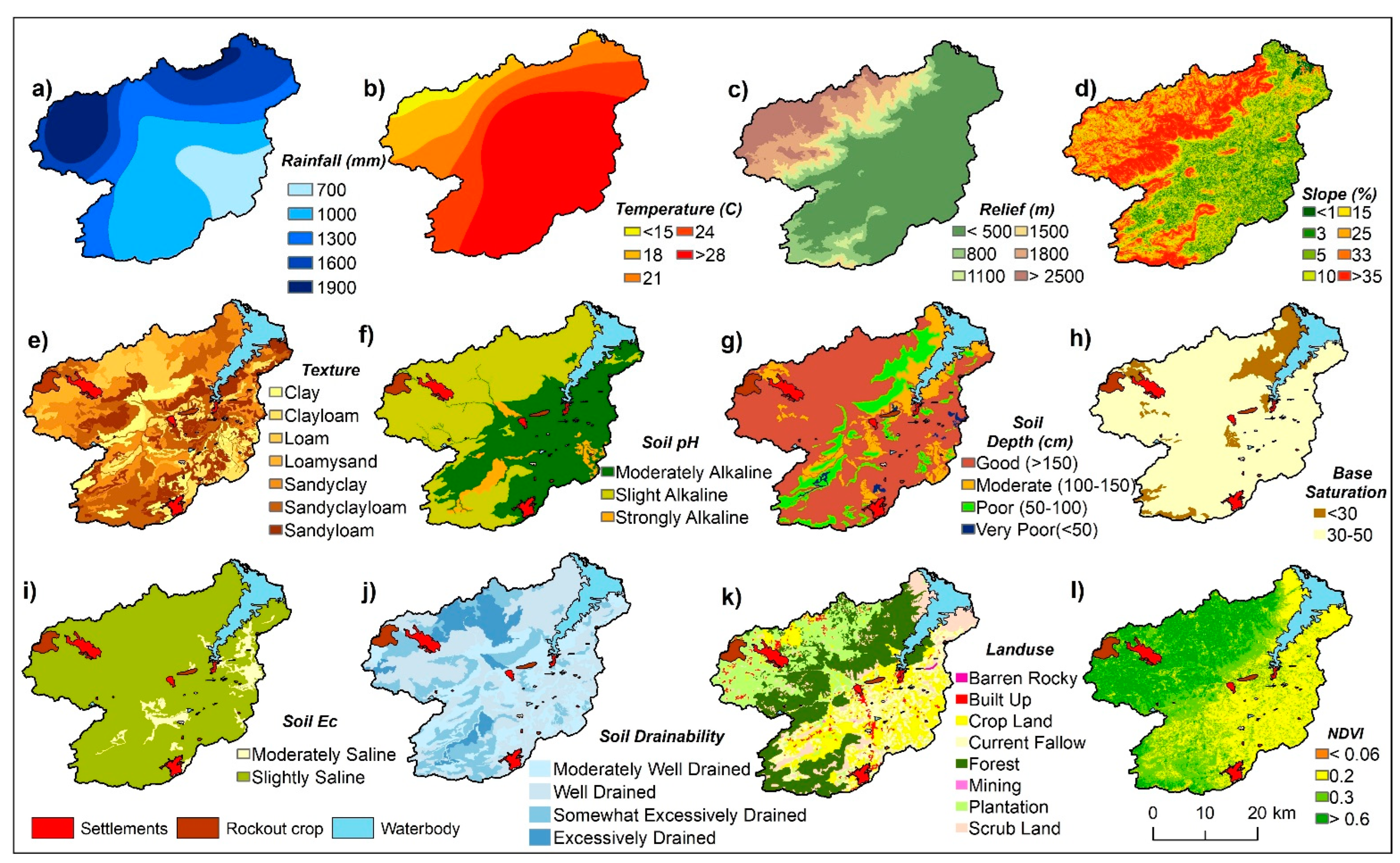
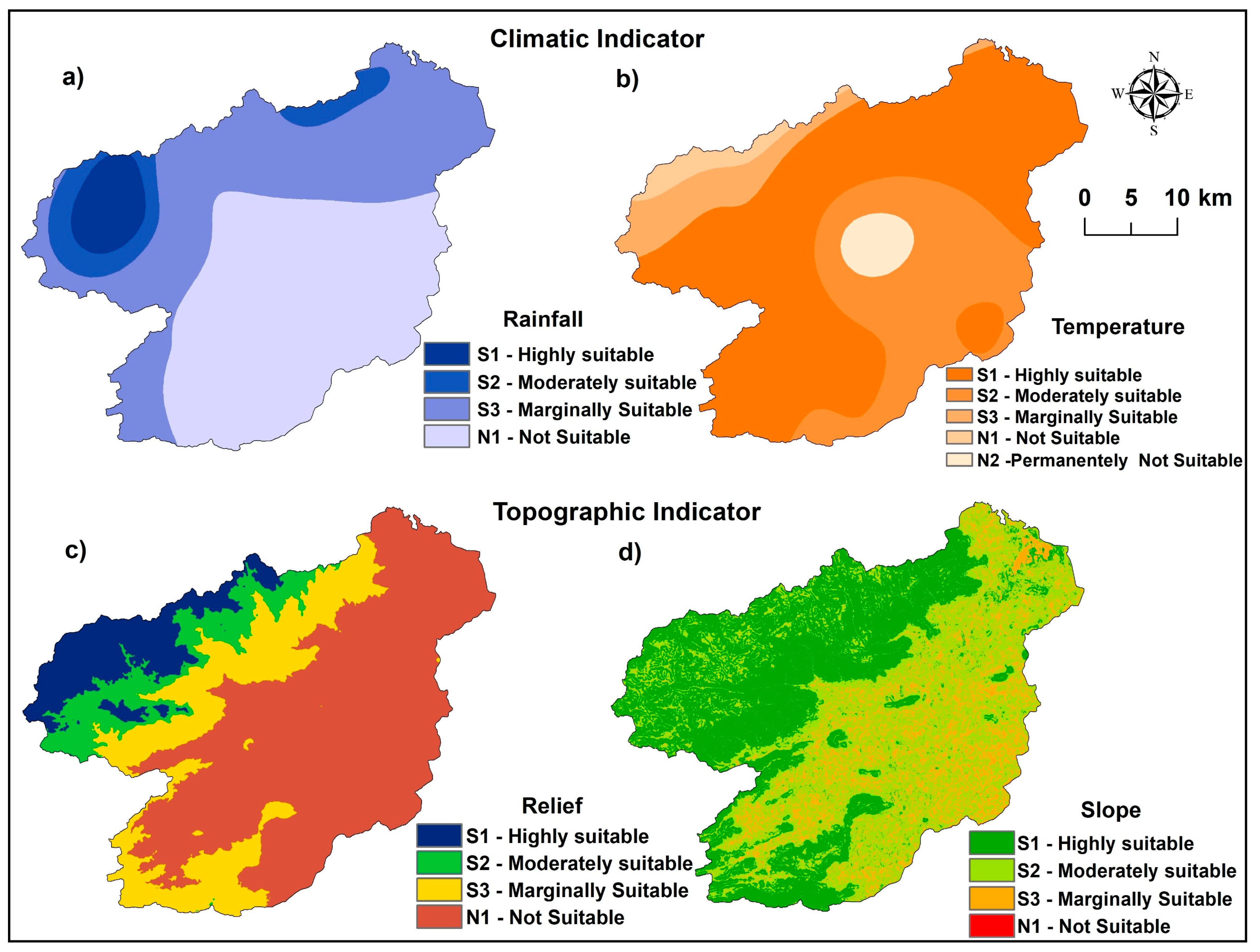
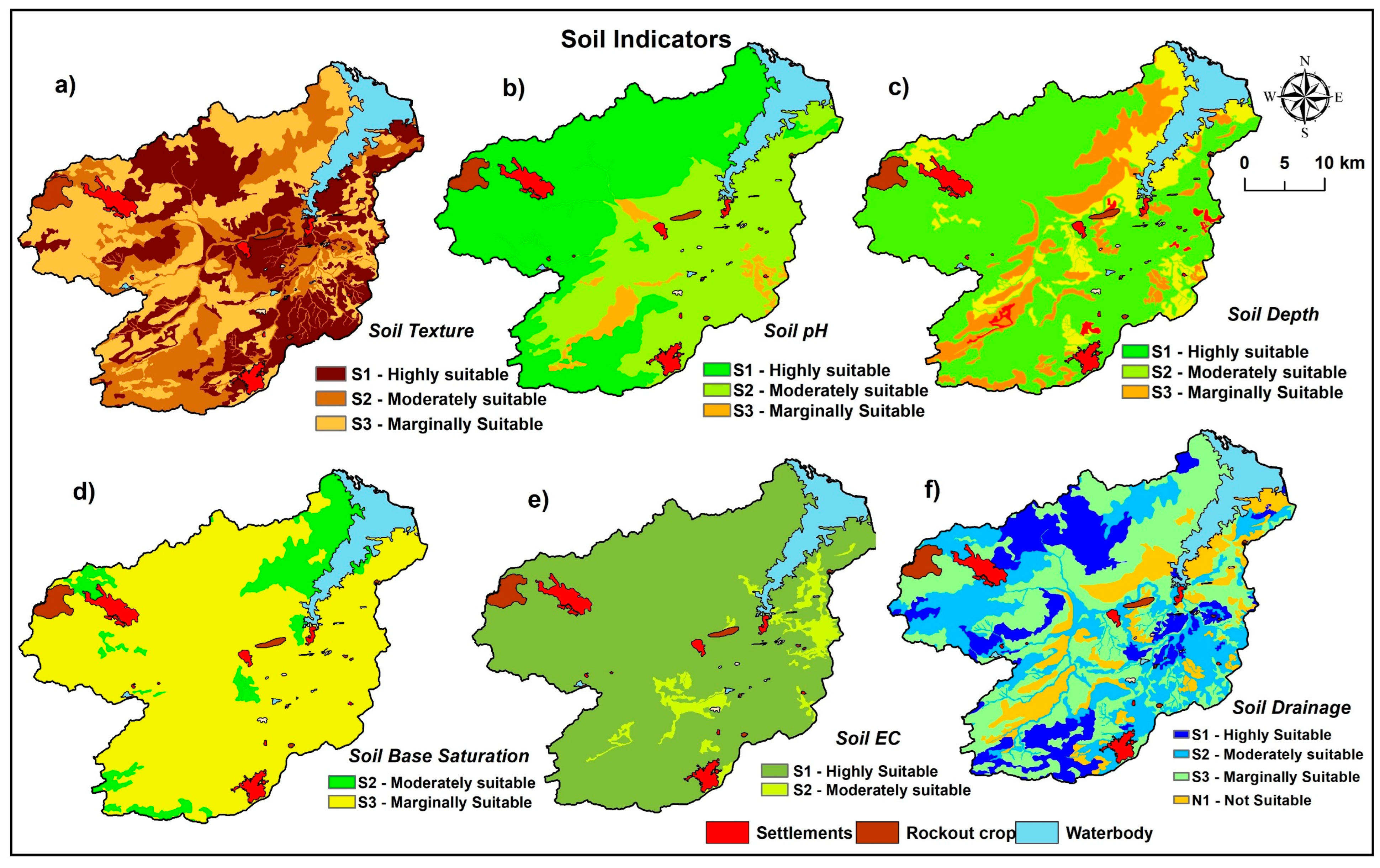
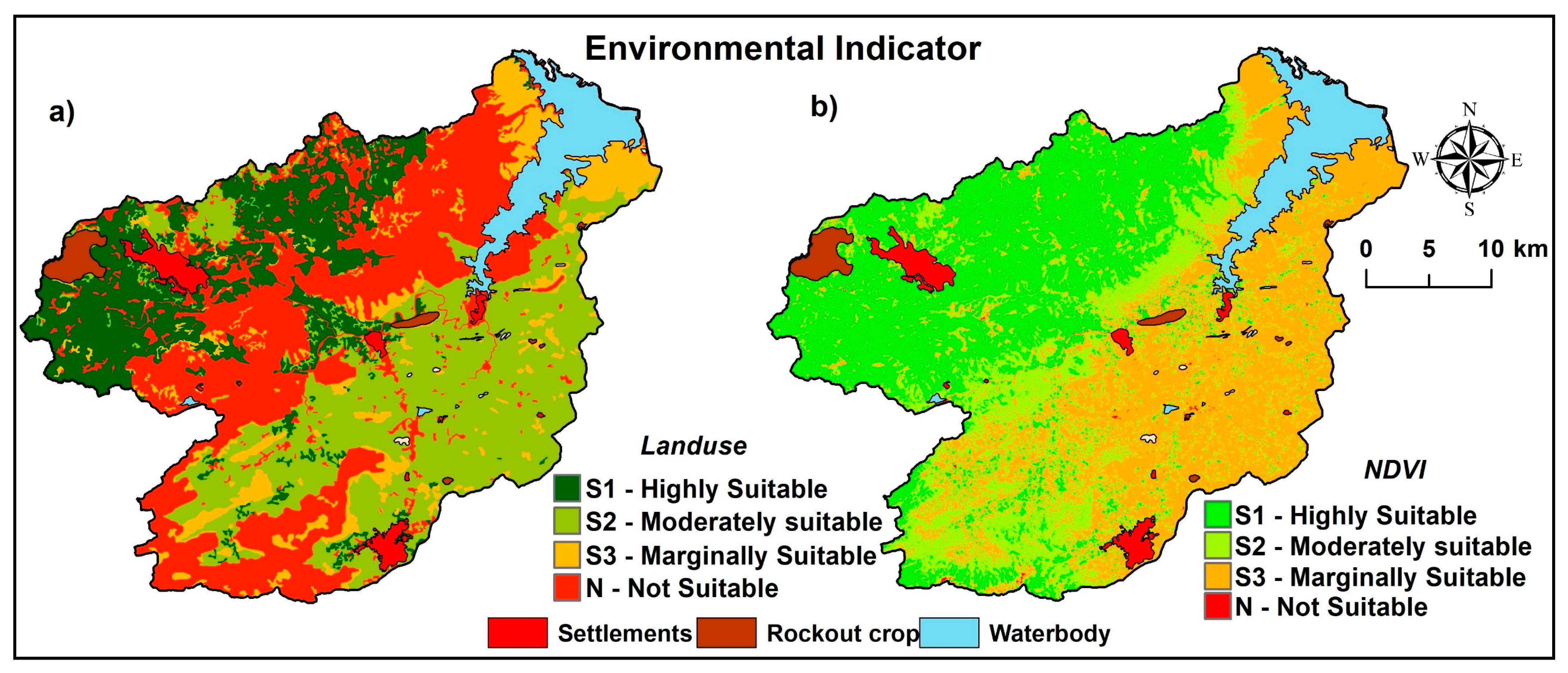
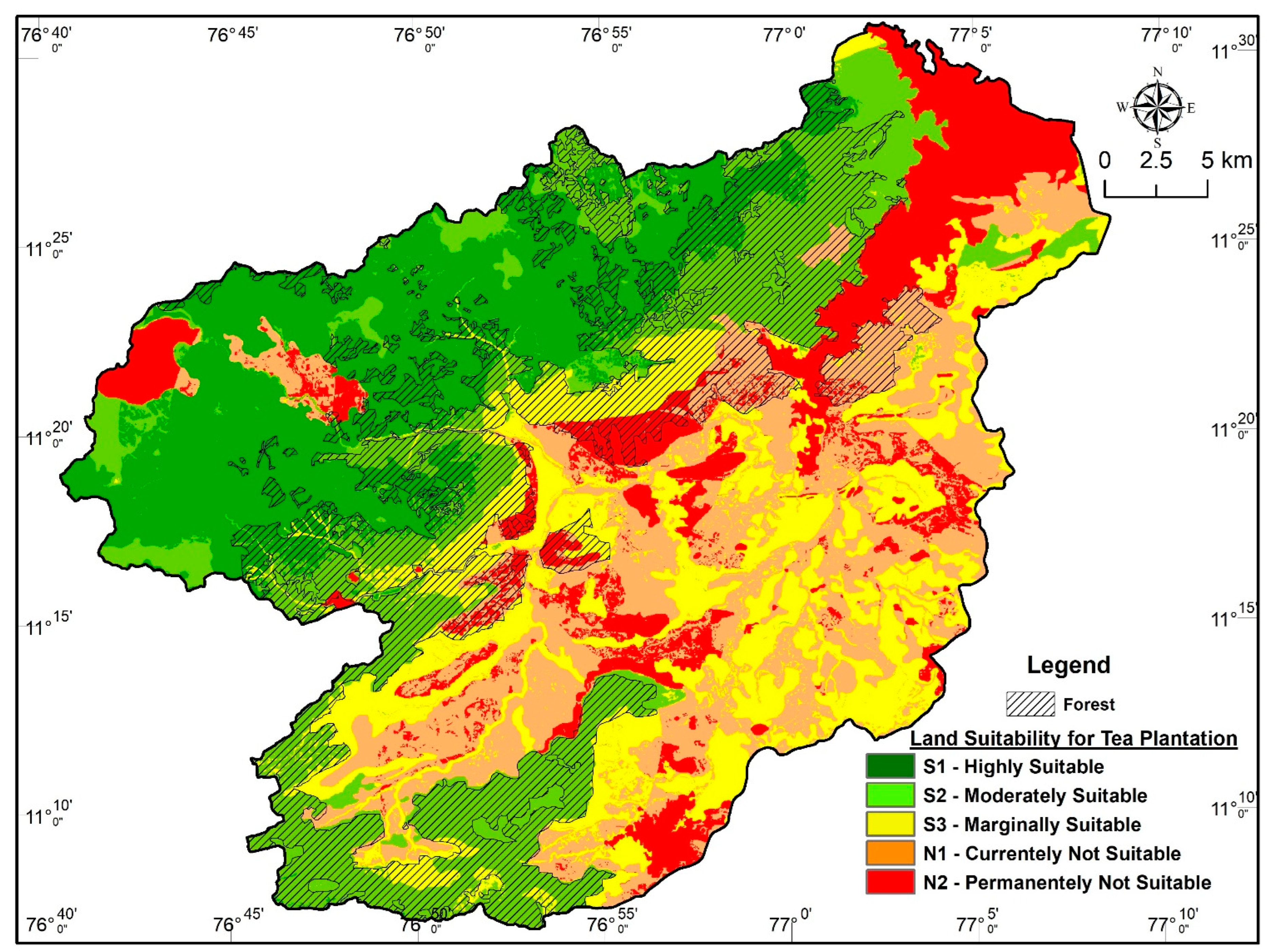
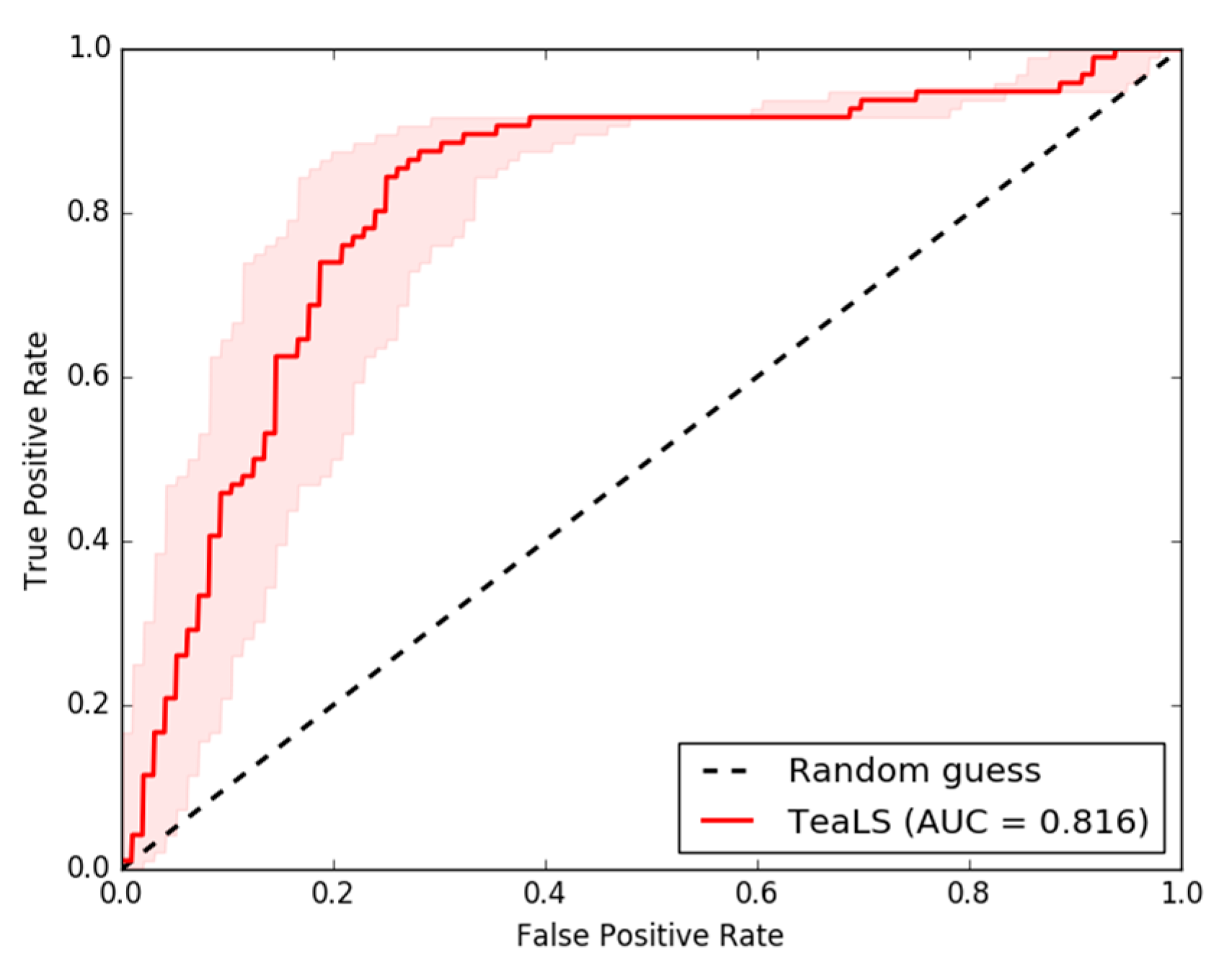

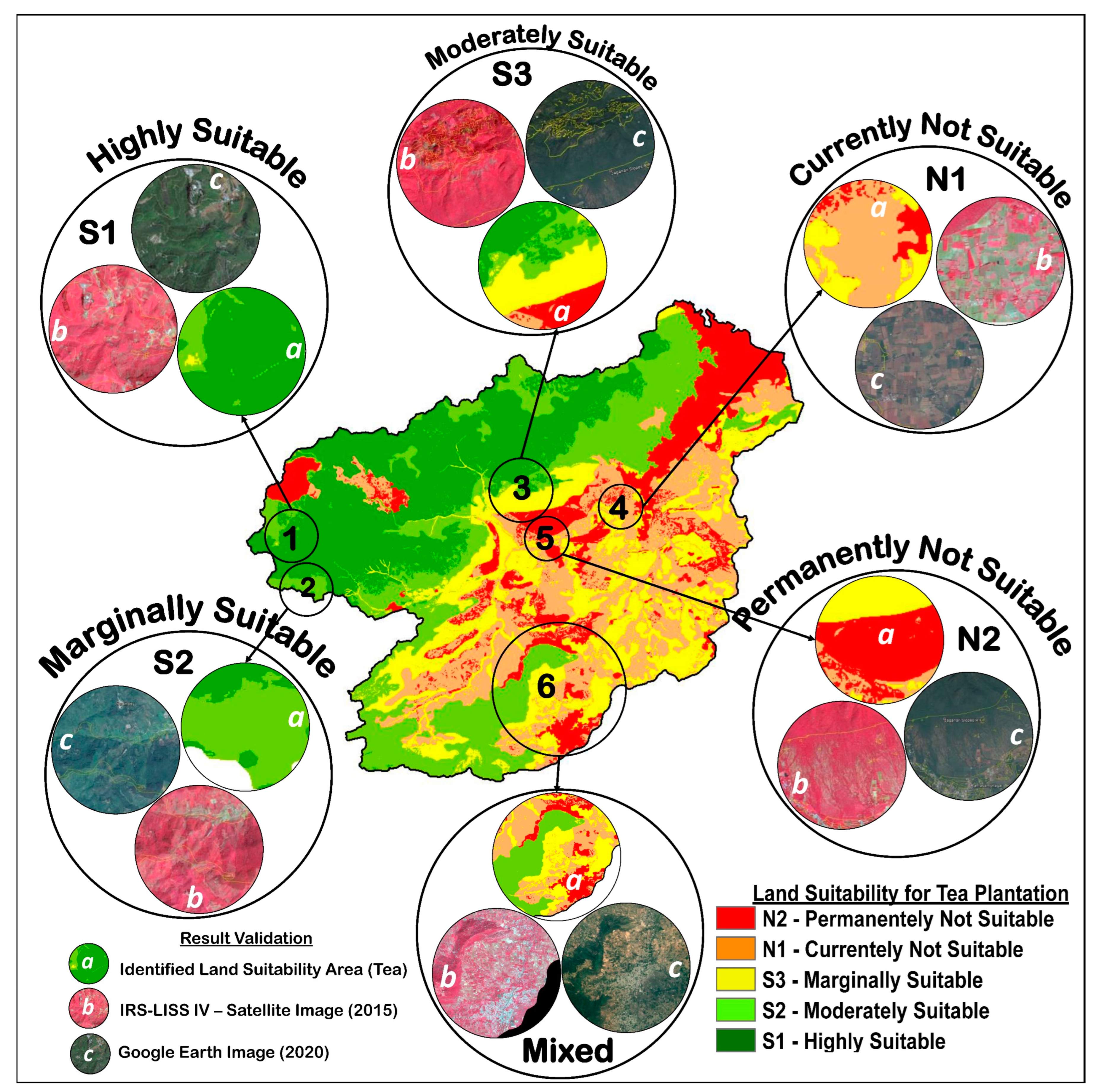
| Scales | Degree of Preferences | Descriptions |
|---|---|---|
| 1 | Equally | Two activities contribute equally to the objective. |
| 3 | Moderately | Experience and judgment slightly to moderately favour one activity over another. |
| 5 | Strongly | Experience and judgment strongly or essentially favour one activity over another. |
| 7 | Very strongly | An activity is strongly favoured over another and its dominance is demonstrated in practice. |
| 9 | Extremely | The evidence of favouring one activity over another is of the highest degree possible of an affirmation. |
| 2, 4, 6, 8 | Intermediate values | Used to represent compromises between the preferences with weights of 1, 3, 5, 7, and 9. |
| Soil Site Characteristics | Rating | |||||
|---|---|---|---|---|---|---|
| Major Characteristics | Factors | Unit | Highly Suitable (S1) | Moderately Suitable (S2) | Marginally Suitable (S3) | Not Suitable (N) |
| Climatic regime | Mean temperature in the growing season | °C | 18–25 | 26–28, 15–17 | 29–30, 13–14 | >30, <13 |
| Total rainfall | mm | 1800–2000 | 1600–1800 | 1000–1600 | <1000 | |
| Land quality | Land characteristics | |||||
| Oxygen availability to roots | Soil drainage | Class | Well-drained | Mod. to imperfectly | Poorly | - |
| Nutrient availability | Texture | Class | sci, I, cl, sl. sil | c, sicl, sic | c(ss), Is, s | - |
| pH | Ratio 1:2.5 | 4.5–5.0 | 5.1–6.0, 4.4–4.0 | 6.1–6.5, <4.0 | >6.5 | |
| BS | % | <30 | 30–50 | <50 | - | |
| Rooting conditions | Effective soil depth | cm | >150 | 100–150 | 50–100 | <50 |
| Soil toxicity | Salinity (EC saturation ex) | dS/m | Non-saline | <1.0 | 1.0–2.0 | - |
| Level I Criteria | Climatic | Topographic | Soil | Environmental | Eigenvector |
|---|---|---|---|---|---|
| Climatic | 1 | 2 | 1/3 | 4 | 0.219 |
| Topographic | 1/2 | 1 | 1/7 | 4 | 0.139 |
| Soil | 3 | 7 | 1 | 6 | 0.581 |
| Environmental | 1/4 | ¼ | 1/6 | 1 | 0.061 |
| λmax = 4.2259 | CI = 0.075 | CR = 0.084 | 1 |
| Sub-Criteria—Climate | Temperature | Rainfall | Eigenvector |
|---|---|---|---|
| Temperature | 1 | ½ | 0.333 |
| Rainfall | 2 | 1 | 0.667 |
| λmax = 2.000 | CI = 0.00 | CR = 0.00 | 1 |
| Sub-Criteria—Topography | Relief | Slope | Eigenvector |
|---|---|---|---|
| Relief | 1 | 3 | 0.750 |
| Slope | 1/3 | 1 | 0.250 |
| λmax = 2.000 | CI = 0.00 | CR = 0.00 | 1 |
| Sub-Criteria—Soil | Soil pH | Soil Texture | Soil Depth | Soil BS | Soil Ec | Soil Drainage | Eigenvector |
|---|---|---|---|---|---|---|---|
| Soil pH | 1 | 1/3 | 2 | 3 | 2 | 2 | 0.208 |
| Soil texture | 3 | 1 | 2 | 3 | 3 | 2 | 0.315 |
| Soil depth | 1/2 | 1/2 | 1 | 2 | 2 | 3 | 0.176 |
| Soil BS | 1/3 | 1/3 | 1/2 | 1 | 2 | 2 | 0.116 |
| Soil Ec | 1/2 | 1/3 | 1/2 | 1/2 | 1 | 1/3 | 0.072 |
| Soil drainage | 1/2 | 1/2 | 1/3 | 1/2 | 3 | 1 | 0.114 |
| λmax = 6.4957 | CI = 0.099 | CR = 0.080 | 1 |
| Sub-Criteria—Environment | LULC | NDVI | Eigenvector |
|---|---|---|---|
| LULC | 1 | 2 | 0.667 |
| NDVI | 1/2 | 1 | 0.333 |
| λmax = 2.000 | CI = 0.00 | CR = 0.00 | 1 |
| Level I | Level II | Level III | Area in Sq.km | Weight | Overall Weight | |
|---|---|---|---|---|---|---|
| Climatic indicator W1 = 0.219 | Rainfall W11 = 0.677 |
| 602.97 527.56 91.49 66.18 | W111 W112 W113 W114 | 0.096 0.161 0.277 0.466 | 0.014 0.024 0.041 0.069 |
| Temperature W12 = 0.333 |
| 36.19 96.97 765.35 346.88 42.82 | W121 W122 W123 W124 W125 | 0.099 0.149 0.434 0.233 0.084 | 0.007 0.011 0.031 0.017 0.006 | |
| Topographic indicator W2 = 0.139 | Relief W21 = 0.750 |
| 739.21 136.44 71.78 75.70 124.49 140.55 | W211 W212 W213 W214 W215 W216 | 0.048 0.066 0.095 0.152 0.235 0.404 | 0.005 0.007 0.010 0.016 0.024 0.042 |
| Slope W22 = 0.250 |
| 172.74 181.37 252.87 109.19 510.69 | W221 W222 W223 W224 W225 | 0.062 0.099 0.161 0.262 0.416 | 0.002 0.003 0.006 0.009 0.014 | |
| Soil indicator W3= 0.581 | Soil texture W31 = 0.315 |
| 103.40 114.82 96.24 84.58 273.96 299.43 200.85 114.17 | W311 W312 W313 W314 W315 W316 W317 W318 | 0.067 0.281 0.198 0.057 0.089 0.104 0.174 0.030 | 0.012 0.052 0.036 0.010 0.016 0.019 0.032 0.006 |
| Soil pH W32 = 0.208 |
| 627.20 499.74 46.35 114.17 | W321 W322 W323 W324 | 0.619 0.198 0.123 0.059 | 0.075 0.024 0.015 0.007 | |
| Soil depth W33 = 0.176 |
| 837.88 153.79 170.24 11.37 114.17 | W331 W332 W333 W334 W335 | 0.096 0.157 0.269 0.423 0.056 | 0.010 0.016 0.027 0.043 0.006 | |
| Soil base saturation W34 = 0.116 |
| 132.32 1041.57 114.29 | W341 W342 W343 | 0.575 0.366 0.059 | 0.039 0.025 0.004 | |
| Soil Ec W35 = 0.072 |
| 1102.02 71.26 114.17 | W351 W352 W353 | 0.575 0.366 0.059 | 0.024 0.015 0.002 | |
| Soil drainability W36 = 0.114 |
| 211.03 321.69 484.98 156.21 114.29 | W361 W362 W363 W364 W365 | 0.489 0.309 0.104 0.056 0.042 | 0.032 0.020 0.007 0.004 0.003 | |
| Environmental indicator W4 = 0.061 | Land use/land cover W41 = 0.667 |
| 1.38 44.85 231.69 181.22 374.65 1.00 248.92 130.80 73.58 | W411 W412 W413 W414 W415 W416 W417 W418 W419 | 0.022 0.028 0.249 0.139 0.077 0.042 0.339 0.054 0.049 | 0.001 0.001 0.010 0.006 0.003 0.002 0.014 0.002 0.002 |
| NDVI W42 = 0.333 |
| 16.46 495.88 425.10 350.76 | W421 W422 W423 W424 | 0.057 0.122 0.263 0.558 | 0.001 0.002 0.005 0.011 | |
| Total | 1285.89 | 1 | ||||
| Suitability Index | Suitability Class | Area in Sq. km | Area in % | Limitation |
|---|---|---|---|---|
| 0.00–0.165 | Highly suitable (S1) | 215.40 | 16.76 | Land has no significant limitations to sustained application |
| 0.165–0.194 | Moderately suitable (S2) | 91.01 | 7.08 | Land has moderate limitations, which is closer to forest regions, and needs a best/practice method. |
| 0.194–0.240 | Marginally suitable (S3) | 209.46 | 16.30 | Marginal limitations are present in these land areas, which affect sustained application (e.g., terrain and slope are not very favourable) |
| 0.240–0.293 | Currently not suitable (N1) | 237.99 | 18.52 | Land has many limitations because the climatic and topographic conditions are not suited for tea plantations |
| 0.293–0.401 | Permanently not suitable (N2) | 157.57 | 12.26 | Settlements, waterbodies, and barren rock |
| Forest | 373.45 | 29.06 | (Restricted/protected area) | |
| Total | 1285.89 | 100 |
| Land Use/Suitability Class | Barren Rocky | Built-Up | Cropland | Current Fallow | Forest | Mining | Tea and Other Plantation | Wasteland | Waterbody | Total |
|---|---|---|---|---|---|---|---|---|---|---|
| Highly suitable (S1) | 0.0 | 6.3 | 20.5 | 0.6 | 70.4 | 0.0 | 176.0 | 11.3 | 0.7 | 286.0 |
| Moderately suitable (S2) | 0.0 | 4.8 | 7.8 | 1.9 | 197.4 | 0.0 | 27.1 | 46.7 | 2.6 | 288.4 |
| Marginally suitable (S3) | 0.2 | 6.8 | 70.0 | 85.1 | 53.8 | 0.5 | 17.8 | 25.8 | 2.9 | 262.8 |
| Currently Not suitable (N1) | 0.8 | 10.2 | 109.4 | 70.6 | 31.3 | 0.0 | 15.9 | 27.8 | 3.9 | 269.9 |
| Permanently Not suitable (N2) | 0.4 | 16.7 | 23.6 | 22.5 | 20.8 | 0.6 | 11.4 | 18.9 | 63.3 | 178.0 |
| Total area (in sq. km) | 1.4 | 44.7 | 231.3 | 180.8 | 373.8 | 1.0 | 248.2 | 130.5 | 73.5 | 1286 |
Publisher’s Note: MDPI stays neutral with regard to jurisdictional claims in published maps and institutional affiliations. |
© 2022 by the authors. Licensee MDPI, Basel, Switzerland. This article is an open access article distributed under the terms and conditions of the Creative Commons Attribution (CC BY) license (https://creativecommons.org/licenses/by/4.0/).
Share and Cite
Rahaman, S.A.; Aruchamy, S. Land Suitability Evaluation of Tea (Camellia sinensis L.) Plantation in Kallar Watershed of Nilgiri Bioreserve, India. Geographies 2022, 2, 701-723. https://doi.org/10.3390/geographies2040043
Rahaman SA, Aruchamy S. Land Suitability Evaluation of Tea (Camellia sinensis L.) Plantation in Kallar Watershed of Nilgiri Bioreserve, India. Geographies. 2022; 2(4):701-723. https://doi.org/10.3390/geographies2040043
Chicago/Turabian StyleRahaman, S. Abdul, and S. Aruchamy. 2022. "Land Suitability Evaluation of Tea (Camellia sinensis L.) Plantation in Kallar Watershed of Nilgiri Bioreserve, India" Geographies 2, no. 4: 701-723. https://doi.org/10.3390/geographies2040043
APA StyleRahaman, S. A., & Aruchamy, S. (2022). Land Suitability Evaluation of Tea (Camellia sinensis L.) Plantation in Kallar Watershed of Nilgiri Bioreserve, India. Geographies, 2(4), 701-723. https://doi.org/10.3390/geographies2040043






